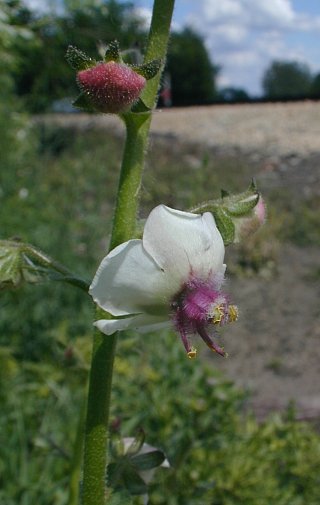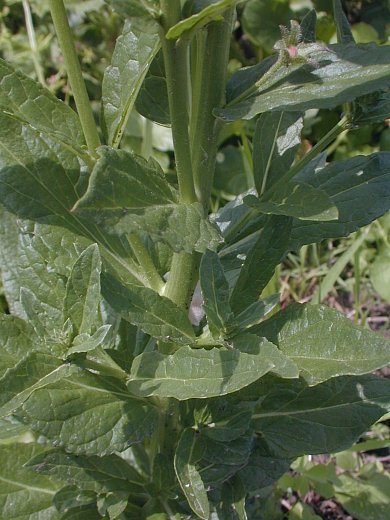 Description:
This herbaceous biennial plant is 1½–3' tall and either unbranched or
sparingly branched. The central stem is stout, ribbed, and usually
glabrous beneath the inflorescence. The basal leaves of 1st-year plants
form a low-growing rosette about 5-10" across. During the second year,
this species bolts upward with alternate leaves along the flowering
stems. They are up to 5" long and 2" across, becoming smaller as they
ascend the stems. The leaves of these 2nd-year plants are broadly
lanceolate with margins that are coarsely crenate or dentate. Sometimes
the margins are slightly undulate and irregular. The lower leaves
strongly clasp the stems, while the upper leaves near the inflorescence
are more likely to be sessile. The upper surface of each leaf is
wrinkled along the veins and hairless. The central stem and upper side
stems (if any) terminate in tall spike-like racemes of flowers about
½–1½' in length. The stalks of these racemes are glandular hairy. Each
flower is ¾–1" across, consisting of 5 spreading petals, 5
stamens, a hairy green calyx with 5 elliptic-lanceolate lobes, and a
single pistil
with a knobby stigma. The petals are either white or yellow, and
they often have purplish pink or greenish brown tints on the surface
facing the calyx. The center of the flower has fine purple hairs around
the stamens and the base of the petals are often some shade of purple
or pink. The pedicel of each flower is about ½" long, and there is a
tapering green bract of about the same length at its base. The blooming
period usually occurs during the summer, and lasts about 1-2 months.
Each flower is replaced by a globoid capsule containing numerous seeds.
The root system consists of a stout taproot. This plant spreads by
reseeding itself.
Description:
This herbaceous biennial plant is 1½–3' tall and either unbranched or
sparingly branched. The central stem is stout, ribbed, and usually
glabrous beneath the inflorescence. The basal leaves of 1st-year plants
form a low-growing rosette about 5-10" across. During the second year,
this species bolts upward with alternate leaves along the flowering
stems. They are up to 5" long and 2" across, becoming smaller as they
ascend the stems. The leaves of these 2nd-year plants are broadly
lanceolate with margins that are coarsely crenate or dentate. Sometimes
the margins are slightly undulate and irregular. The lower leaves
strongly clasp the stems, while the upper leaves near the inflorescence
are more likely to be sessile. The upper surface of each leaf is
wrinkled along the veins and hairless. The central stem and upper side
stems (if any) terminate in tall spike-like racemes of flowers about
½–1½' in length. The stalks of these racemes are glandular hairy. Each
flower is ¾–1" across, consisting of 5 spreading petals, 5
stamens, a hairy green calyx with 5 elliptic-lanceolate lobes, and a
single pistil
with a knobby stigma. The petals are either white or yellow, and
they often have purplish pink or greenish brown tints on the surface
facing the calyx. The center of the flower has fine purple hairs around
the stamens and the base of the petals are often some shade of purple
or pink. The pedicel of each flower is about ½" long, and there is a
tapering green bract of about the same length at its base. The blooming
period usually occurs during the summer, and lasts about 1-2 months.
Each flower is replaced by a globoid capsule containing numerous seeds.
The root system consists of a stout taproot. This plant spreads by
reseeding itself.
Cultivation:
Moth Mullein is an adaptable plant that usually grows in full sunlight,
moist to dry conditions, and rather poor soil that contains gravel or
clay. In dry poor soil, this plant can be rather small, while at sites
with fertile soil and more moisture it can become rather large.
Range & Habitat:
The non-native Moth Mullein is a common plant that occurs in most
counties of
Illinois. However, it is less common or absent in NW Illinois (see Distribution
Map). This species originated from Eurasia. Habitats include
pastures, abandoned fields, vacant lots, irregularly mowed lawns, areas
along roadsides and railroads, and gravel bars along rivers. It prefers
highly disturbed areas and is not invasive of natural areas to any
significant degree.
Faunal Associations:
The pollen of the flowers is collected by bumblebees and Halictid bees.
Syrphid flies feed on the pollen, but they are probably not effective
at cross-pollination. Little information appears to be available about
this
species' relationships to birds and mammals.

Photographic
Location:
An irregularly mowed vacant lot near a railroad in Urbana, Illinois.
There were groundhogs with dens nearby, but they did not appear to
bother this species, preferring other plants.
Comments:
This is a variable species with attractive flowers and unattractive
foliage. There are two basic color forms: plants that produce yellow
flowers, and those that produce white flowers. The common name refers
to the fancied resemblance of the flowers to moths. Moth Mullein often
produces a spike-like raceme of flowers of exceptional length,
considering the size of the plant. It has a very different appearance
from Verbascum thaspum (Great Mullein), although
they are both tall-growing and spike-like. Great Mullein has less showy
yellow flowers, and its leaves are larger in size and covered with
fuzzy white hairs.